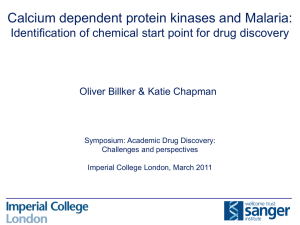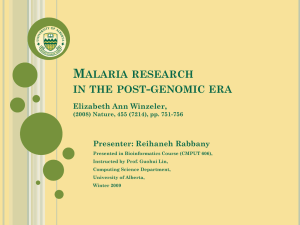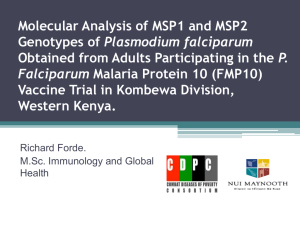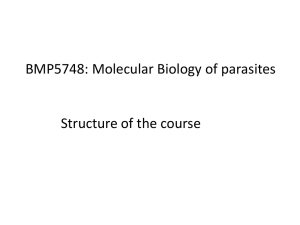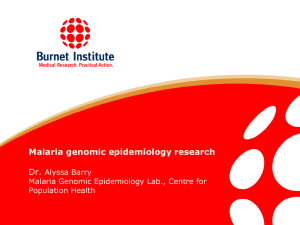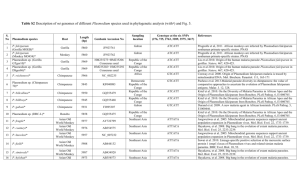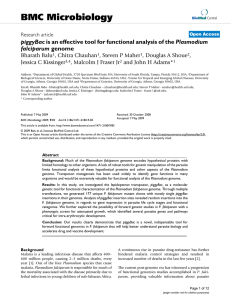Parasite protein kinases: At home and abroad - HAL
advertisement
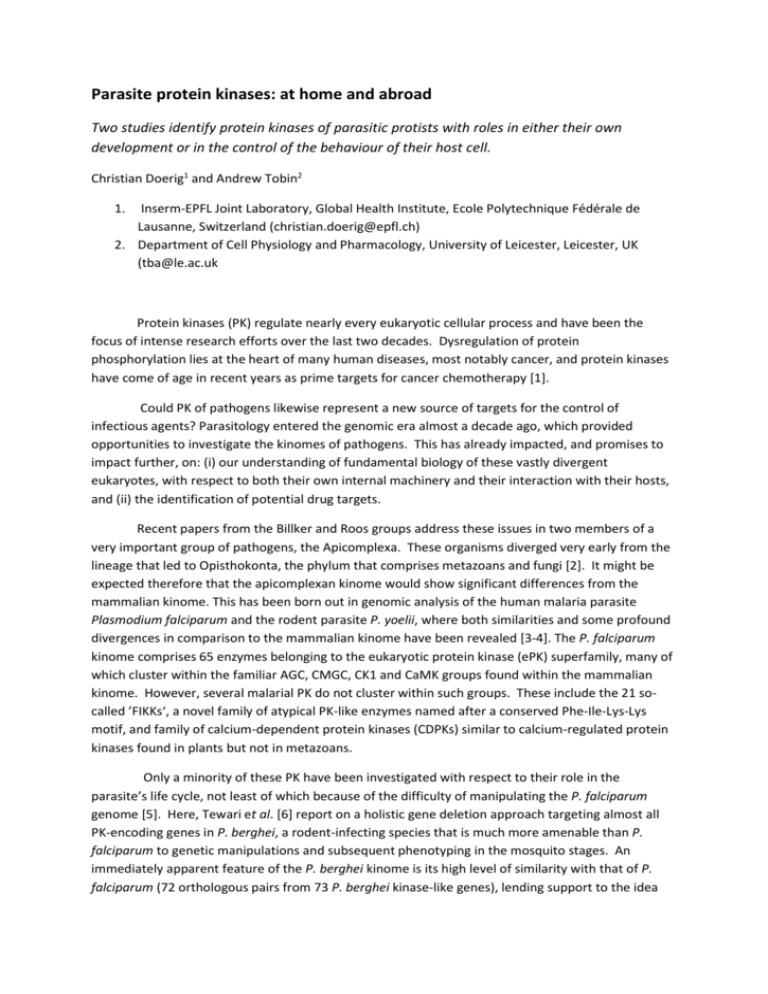
Parasite protein kinases: at home and abroad Two studies identify protein kinases of parasitic protists with roles in either their own development or in the control of the behaviour of their host cell. Christian Doerig1 and Andrew Tobin2 1. Inserm-EPFL Joint Laboratory, Global Health Institute, Ecole Polytechnique Fédérale de Lausanne, Switzerland (christian.doerig@epfl.ch) 2. Department of Cell Physiology and Pharmacology, University of Leicester, Leicester, UK (tba@le.ac.uk Protein kinases (PK) regulate nearly every eukaryotic cellular process and have been the focus of intense research efforts over the last two decades. Dysregulation of protein phosphorylation lies at the heart of many human diseases, most notably cancer, and protein kinases have come of age in recent years as prime targets for cancer chemotherapy [1]. Could PK of pathogens likewise represent a new source of targets for the control of infectious agents? Parasitology entered the genomic era almost a decade ago, which provided opportunities to investigate the kinomes of pathogens. This has already impacted, and promises to impact further, on: (i) our understanding of fundamental biology of these vastly divergent eukaryotes, with respect to both their own internal machinery and their interaction with their hosts, and (ii) the identification of potential drug targets. Recent papers from the Billker and Roos groups address these issues in two members of a very important group of pathogens, the Apicomplexa. These organisms diverged very early from the lineage that led to Opisthokonta, the phylum that comprises metazoans and fungi [2]. It might be expected therefore that the apicomplexan kinome would show significant differences from the mammalian kinome. This has been born out in genomic analysis of the human malaria parasite Plasmodium falciparum and the rodent parasite P. yoelii, where both similarities and some profound divergences in comparison to the mammalian kinome have been revealed [3-4]. The P. falciparum kinome comprises 65 enzymes belonging to the eukaryotic protein kinase (ePK) superfamily, many of which cluster within the familiar AGC, CMGC, CK1 and CaMK groups found within the mammalian kinome. However, several malarial PK do not cluster within such groups. These include the 21 socalled ’FIKKs‘, a novel family of atypical PK-like enzymes named after a conserved Phe-Ile-Lys-Lys motif, and family of calcium-dependent protein kinases (CDPKs) similar to calcium-regulated protein kinases found in plants but not in metazoans. Only a minority of these PK have been investigated with respect to their role in the parasite’s life cycle, not least of which because of the difficulty of manipulating the P. falciparum genome [5]. Here, Tewari et al. [6] report on a holistic gene deletion approach targeting almost all PK-encoding genes in P. berghei, a rodent-infecting species that is much more amenable than P. falciparum to genetic manipulations and subsequent phenotyping in the mosquito stages. An immediately apparent feature of the P. berghei kinome is its high level of similarity with that of P. falciparum (72 orthologous pairs from 73 P. berghei kinase-like genes), lending support to the idea that P. berghei is a useful model when it comes to PK function. Notable differences, however, are the absence of expansion of FIKKs in P. berghei (which possesses a single FIKK), as well as three PK sequences that are represented only in one of the two species. Systematic gene deletion attempts led Tewari and her colleagues to designate the P. berghei PK into three groups: (i) deletable with no detectable developmental phenotype; (ii) deletable with a developmental phenotype in sexual development; and (iii) non-deletable. The first two groups together comprise 23 PK genes for which knock-out (KO) clones could be obtained, indicating redundancy for asexual proliferation in erythrocytes, the stage of the life cycle where transfection is performed and selection occurs. Among these, 11 did not display any developmental block and could complete their life cycle, productively infecting both mice and mosquitoes. The most informative group of PK were those whose gene deletion caused a developmental block during the sexual cycle and hence can be considered as genetically validated targets for transmission-blocking intervention. The 12 remaining PK are thus found to be required for various stages of the transmission process (e.g. exflagellation of male gametocytes, ookinete or oocyst development, and sporozoite maturation). Essential roles for CDPK4, map-2, nek-2, and nek-4 in exflagellation and meiosis had been previously documented by the same authors; exciting novel information from the Tewari et al. paper concerns both SRPK, a putative splicing regulator whose deletion blocks male gametocyte exflagellation, as well as a homologue of the cyclin G-activated kinase, the most likely Plasmodium candidate for the kinase that regulates clathrin vesicle uncoating and which is required for ookinete maturation. Furthermore, PK7, an atypical PK with no orthologues in yeast or metazoans and known to be essential for oocyst formation in P. falciparum [7-8] is now shown to be required at the earlier stage of ookinete formation in P. berghei, as PbPK7 KO clones produce only 10% ookinetes relative to wild-type parasites (the reason for the low penetrance of this phenotype is unclear). The few ookinetes that succeed in establishing an oocyst do not produce sporozoites, indicating a crucial function for the enzyme at more than one developmental stage transition. Additional protein kinases are now known to be essential for invasion of the mosquito’s salivary glands and for sporozoite infectivity. Thus, this systematic reverse genetics approach provides an important platform from which to target selective protein kinases in drugs designed as transmission blockers. A somewhat surprising finding is that no PK knock-out resulted in abolition of the capacity to undergo gametocytogenesis. In the operationally similar case of yeast mating type differentiation, cell cycle arrest and the sexual development programme is triggered by activation of the MAP kinase pathway, and deletion of the PK in this pathway causes a clear sterile phenotype [9]. It may be that a similar pathway operates in malaria parasites, but that the PK involved, if any, are required not only for sexual differentiation but also play crucial roles in asexual parasite proliferation. These are therefore hidden among the last group, that of PK whose genes were not deletable. The largest functional group contains the 43 genes that are refractory to deletion, and are consequently considered as potentially essential for asexual proliferation in erythrocytes. The authors suggest these should be given priority in the context of the definition of targets for curative antimalarial drug discovery. They accurately point out, however, that failure to select KO parasites is not proof that gene deletion is indeed lethal. Instead, it can result from reduced fitness in comparison to parasites in the same population that carry the transfected plasmid but have not undergone recombination at the target locus. Another point to consider is that selection of clones with recombined loci is a lengthy process in comparison with generation time and may give opportunities for the selection of compensatory modifications. One such example is given by the KO phenotype of Pfmap-1, one of the two MAP kinases in the P. falciparum kinome; whereas the pfmap2 gene could not be inactivated and thus appears to play an important role in asexual proliferation, clones with a disrupted pfmap-1 gene were readily obtained and no developmental phenotype was observed in asexual blood stage or in the sexual cycle. There was a subtle phenotype; pfmap-1- blood stage parasites grossly over-express the Pfmap-2 protein [10]. This strongly suggests that Pfmap-1 does in fact also play a role in asexual growth that requires adaptive response if the gene is absent. The map-2 gene is required for exflagellation but not for asexual growth in P. berghei [6], whereas its P. falciparum orthologue appears to be essential for completion of the asexual cycle [10]. It will be of interest to determine to what extent such phenotypic differences can be documented between the rodent model species and the human pathogen. Another recent study published in this journal that brings an important stone to the edifice of parasite functional kinomics comes from the Roos laboratory in Peixoto et al. [11]. These authors found that the kinome of Toxoplasma gondii, another Apicomplexan of considerable medical importance, although larger than that of malaria parasites, shares the same broad features: the presence of many protein kinases that can be assigned to established ePK groups, and ,reminiscent of the FIKK family found in P. falciparum, the presence of a 44-member family of atypical protein kinases, the ROPKs (for rhoptry kinases, named after the secretory organelle to which these enzymes localise in the infective parasite; some members had been characterised previously [12]). The FIKKs and ROPKs are unrelated to each other and appear to have evolved independently under positive selection; both families are, however, characterised by signal peptides targeting the enzymes to the host cell, and indeed some FIKKs and ROPKs have been localised in the respective parasitophorus vacuole of host cells of P. falciparum and T. gondii. Pexeito et al. report that expression levels of a previously uncharacterised ROPK (ROP38) vary between T. gondii strains and negatively correlate with virulence. Another difference between virulent and avirulent strains is the extent to which the host cell transcriptome is affected by infection. Just about 400 transcripts are affected by an avirulent strain, whereas >6000 host cell genes are reproducibly up- or down-regulated by infection with a virulent strain. So the natural question was: is the impact of infection on the host cell transcriptome mediated by ROP38? To provide an answer, the authors engineered a virulent strain to over-express the kinase, and monitored the effect of infection on the host cell transcriptome. They found that this effect was suppressed by approximately two-fold over the ROP38 engineered line, pointing to interference with a host cell MAPK pathway (this was confirmed by phospho-specific Western blot analyses of pathway components). The dramatic influence of ROP38 expression on the host transcriptome does not appear to be reflected by changes in virulence, indicating that a high level of ROP38 expression is not sufficient to dampen virulence. Nevertheless, these experiments demonstrate a role for an exported kinase-like molecule in remodeling of the host cell, in this case by affecting gene expression. This is certainly similar but distinct from the proposed role in erythrocyte cytoskeleton remodeling by P. falciparum FIKKs [13]. The studies from the Billker and Roos laboratories further illustrate the crucial importance of protein phosphorylation in: (i) the cell biology of Apicomplexan parasite development, and (ii) the intimate interactions of parasites with their host cells. It will be of great interest to investigate the receiving end of the kinomics game, i.e. the complement of phosphorylated sites in the proteomes of the parasite and their host cells. Once a baseline is available for various developmental stages, comparative phosphoproteomics of wild-type parasites and clones lacking specific protein kinases, or, better, of lines with regulatable expression of the same enzymes, will be hugely informative with respect to the regulatory networks that operate to sustain the complex life cycle of these dreadfully important pathogens. 1. 2. 3. 4. 5. 6. 7. 8. 9. 10. 11. 12. Zhang, J., P.L. Yang, and N.S. Gray, Targeting cancer with small molecule kinase inhibitors. Nat Rev Cancer, 2009. 9(1): p. 28-39. Baldauf, S.L., The deep roots of eukaryotes. Science, 2003. 300(5626): p. 1703-6. Ward, P., L. Equinet, J. Packer, and C. Doerig, Protein kinases of the human malaria parasite Plasmodium falciparum: the kinome of a divergent eukaryote. BMC Genomics, 2004. 5(1): p. 79. Anamika, K. and N. Srinivasan, Comparative kinomics of Plasmodium organisms: unity in diversity. Protein Pept Lett, 2007. 14(6): p. 509-17. Carvalho, T.G. and R. Menard, Manipulating the Plasmodium genome, in Malaria parasites: genomes and molecular biology, A.P. Waters and C. Janse, Editors. 2004, Caister Academic Press: Wymondham, UK. p. 101-134. Tewari, R., To be completed. 2010. Dorin, D., J.P. Semblat, P. Poullet, P. Alano, J.P. Goldring, C. Whittle, S. Patterson, D. Chakrabarti, and C. Doerig, PfPK7, an atypical MEK-related protein kinase, reflects the absence of classical three-component MAPK pathways in the human malaria parasite Plasmodium falciparum. Mol Microbiol, 2005. 55(1): p. 184-96. Dorin-Semblat, D., A. Sicard, C. Doerig, L. Ranford-Cartwright, and C. Doerig, Disruption of the PfPK7 gene impairs schizogony and sporogony in the human malaria parasite Plasmodium falciparum. Eukaryot Cell, 2008. 7(2): p. 279-85. Bardwell, L., A walk-through of the yeast mating pheromone response pathway. Peptides, 2005. 26(2): p. 339-50. Dorin-Semblat, D., N. Quashie, J. Halbert, A. Sicard, C. Doerig, E. Peat, L. Ranford-Cartwright, and C. Doerig, Functional characterization of both MAP kinases of the human malaria parasite Plasmodium falciparum by reverse genetics. Mol Microbiol, 2007. 65(5): p. 1170-80. Peixoto, L., F. Chen, O.S. Harb, P.H. Davis, D.P. Beiting, C.S. Brownback, D. Ouloguem, and D.S. Roos, Integrative genomic approaches highlight a family of parasite-specific kinases that regulate host responses. Cell Host Microbe. 8(2): p. 208-18. El Hajj, H., E. Demey, J. Poncet, M. Lebrun, B. Wu, N. Galeotti, M.N. Fourmaux, O. MercereauPuijalon, H. Vial, G. Labesse, and J.F. Dubremetz, The ROP2 family of Toxoplasma gondii rhoptry proteins: proteomic and genomic characterization and molecular modeling. Proteomics, 2006. 6(21): p. 5773-84. 13. Nunes, M.C., M. Okada, C. Scheidig-Benatar, B.M. Cooke, and A. Scherf, Plasmodium falciparum FIKK kinase members target distinct components of the erythrocyte membrane. PLoS One. 5(7): p. e11747.
